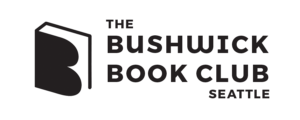Over at Powell’s blog recently, Josh Hanagarne wrote about books that have the power to change lives. He mused over all the people he had encountered who claimed that a book had changed their life, but when questioned gave such a dissatisfying answer:
“How?” I said. Meaning, how did it change your life?
“Because it was amazing!” she said.
This is a pretty typical response, and I know I do it sometimes as well.
“Because it was just so good!”
“It was incredible!”
“I loved it!”
These are all great to hear, but none of them indicate any clues about how a life might have been changed…
Here at Bushwick Seattle, we are all book lovers. Saying what we love about a book is what we do. At every show our musicians articulate this sometimes intangible, mysterious force that weds us to the page. Whether it’s Del Ray’s love of Lydia Bennett’s particular brand of silliness (or rather, as Jane Austen says, the ability to be “ungovernable”) or Tai Shan’s empathy with Wendy Torrance in The Shining, the whole night is about the “why?” of what makes a book one that you love.
A life-changing book, however, is quite another thing. There have only been a few books that I can give life-changing status, and even then I’m not exactly sure if I could pass Hanagarne’s test. The closest that I can get is this:
In graduate school I signed up for a seminar on Ernest Hemingway. I never thought I’d like it. I was a feminist and Hemingway was perhaps the most famous alpha male of the literary world, and notoriously unable to write women characters. I was at a point in my life where I was purposefully ignoring literary greats (the dusty, old male-dominated canon) to read contemporary writers of the female variety.
But then there was In Our Time, Hemingway’s first short story collection. The collection is good, yes, but not life-changing…until I hit the final two stories: Big Two-Hearted River, Parts I and II.
These stories feature Hemingway’s Nick Adams character alone in the countryside. He hikes, sits on a stump and smokes, naps, opens a can of beans, boils water for coffee, fishes. He thinks. He sleeps.

…Nick felt happy. He felt he had left everything behind, the need for thinking, the need to write, other needs. It was all back of him.
Not much happens. The stories are descriptive, not plot-driven. Nick speaks only three times: once to a grasshopper, once out loud to himself, and once with his mouth full of food (“’Chrise,’ Nick said, ‘Geezus Chrise,’ he said happily.”).
The stories are about the aftermath of war. They are about being alone. Maybe a bit about healing, reconciling the past and present. The stories made me want to fish, to be alone for a while and eat what I caught. This might seem funny to anyone who knows me, but it’s true.
It’s been at least six years since I read about that big two-hearted river, and I haven’t yet been fishing. So maybe that means that my life hasn’t changed in any tangible way after all, but there are many times when things get crazy and I’m yearning for escape and I think about that river, those grasshoppers to which Nick says “Go on, hopper…Fly away somewhere.”
I still plan to fish, someday.
What about you, Seattle? What books have changed your life? Why? How? Tell us about them.
Tweet your answers #lifechangingbooks @iReadandSing












Connect With Bushwick